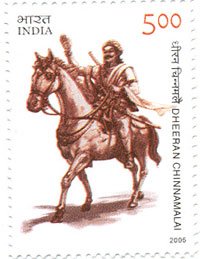Dheeran Chinnamalai (1756-1805)

Technical Data
| Stamp Set | Death Bicentenary |
|---|---|
| Date of Issue | July 31, 2005 |
| Denomination | Rs. 5 |
| Quantity | 400,000 |
| Perforation | comb 13¼ x 13½ |
| Printer | Security Printing Press, Nashik |
| Watermark | No Watermark |
| Colors | Multicolor |
| Catalog Codes |
Michel IN 2093 Stamp Number IN 2111 Yvert et Tellier IN 1858 Stanley Gibbons IN 2277 WADP Numbering System - WNS IN024.05 |
| Themes | Animals (Fauna) | Anniversaries and Jubilees | Equestrianism and horse riding | Famous people | Freedom Fighters | Horses | Mammals | Men |
Table of Contents
Commemorative Stamp Set: Death Bicentenary of Dheeran Chinnamalai (1756-1805)
Design Elements
- Portrait: The stamp features a powerful depiction of Dheeran Chinnamalai, showcasing his warrior spirit. He is portrayed wearing traditional Tamil warrior attire, holding a spear, with his characteristic valor reflected in his expression.
- Background: The backdrop includes battle scenes from the Polygar Wars, with rolling hills and fortresses symbolizing the terrain of his native Kongu region. It also includes the depiction of his fort, Odanilai Fort, as a significant symbol of his military strategy.
- Colors: Rich, earthy tones like deep red, bronze, and green are used to highlight the strength and connection to the land he defended.
Cultural and Historical Significance
- Dheeran Chinnamalai was a heroic freedom fighter and leader in the Polygar Wars against the British East India Company. As a prominent chieftain from the Kongu region, he played a crucial role in resisting British colonial rule and defending his people’s land and culture.
- His guerrilla warfare tactics and unwavering courage made him a significant figure in early resistance against British domination in India. His sacrifice and dedication to his homeland continue to inspire pride and patriotism among people, particularly in Tamil Nadu.
Usage
- Postage: The stamp can be used for everyday mail, spreading awareness of Dheeran Chinnamalai’s contributions to India’s freedom struggle across the nation.
- Educational Material: Schools and historical societies may use the stamp to educate students about early resistance movements in India and the role of regional heroes in the fight for independence.
- Philatelic Collections: An essential addition to collections focused on Indian freedom fighters and significant historical events, enriching the narrative of India’s struggle for independence.
Importance of the Commemorative Stamp Set
- This commemorative stamp set honors the legacy of Dheeran Chinnamalai, celebrating his pivotal role in early Indian resistance against colonial rule. It serves as a reminder of the sacrifices made by local chieftains and the importance of preserving regional histories and cultural identities.
- The stamps not only highlight his valor and leadership but also bring attention to the broader story of the Polygar Wars, which were crucial in shaping the anti-colonial sentiment in southern India.
Example of the Stamp Design
- Primary Stamp: Features Dheeran Chinnamalai in a commanding pose, with Odanilai Fort in the background and a battle scene unfolding behind him. The year “1805” is inscribed to mark his death bicentenary.
The Commemorative Stamp Set Might Include:
- First Day Cover: A special cover with artwork depicting key moments from the Polygar Wars, such as Chinnamalai’s confrontations with British forces, alongside a commemorative cancellation mark.
- Souvenir Sheet: A collectible sheet with multiple stamps illustrating different aspects of his life, including his leadership, military strategies, and cultural significance.
- Informative Brochure: A booklet detailing his life story, the significance of his resistance, and how his legacy lives on in contemporary Tamil Nadu.
Significance
- The death bicentenary commemorative stamp set of Dheeran Chinnamalai commemorates his fearless resistance and the spirit of self-determination he embodied. By honoring his contributions, the stamp set educates people about the valor and resilience of local heroes who laid the groundwork for India’s fight for freedom and preserves the cultural heritage of the Kongu region.
